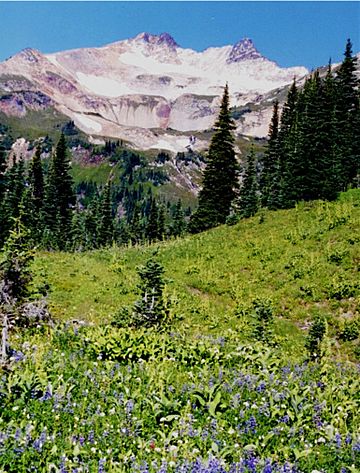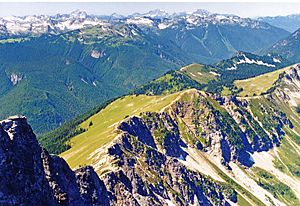Plummer Mountain facts for kids
Quick facts for kids Plummer Mountain |
|
|---|---|

Plummer Mountain seen from Suiattle Pass
|
|
| Highest point | |
| Elevation | 7,870 ft (2,400 m) |
| Prominence | 1,950 ft (590 m) |
| Geography | |
| Parent range | Cascade Range |
| Topo map | USGS Suiattle Pass |
| Geology | |
| Age of rock | Cretaceous |
| Mountain type | Metamorphic brown Gneiss |
| Climbing | |
| Easiest route | Scrambling |
Plummer Mountain is a tall and important peak in the North Cascades, located in Snohomish County, Washington state. It stands west of Suiattle Pass, deep inside the beautiful Glacier Peak Wilderness. This area is managed by the Mount Baker-Snoqualmie National Forest. Plummer Mountain is the highest point on Miners Ridge. A great place to camp before climbing Plummer Mountain is near Image Lake on Miners Ridge. Years ago, there were plans to dig a large mine on Plummer Mountain. However, many people worked together to protect the mountain, and the mining plans were stopped.
Contents
How Plummer Mountain Formed
Plummer Mountain was created by powerful forces deep within the Earth. About 90 million years ago, during the late Cretaceous period, the land here was under the ocean. It was made of sedimentary and volcanic rocks.
Around 35 million years ago, a lot of volcanic activity happened. But the main mountain building, called uplift, didn't start until about 10 million years ago. Plummer Mountain is part of a large rock formation called the Cloudy Pass batholith. This formation was created about 20 million years ago when hot, melted rock pushed up from deep underground.
Glacier Peak, a large stratovolcano (a cone-shaped volcano), is south of Plummer Mountain. Because Glacier Peak is so close, you can often find volcanic ash in the area.
The Impact of Glaciers
During the ice age, thick glaciers covered most of the North Cascades. These huge ice sheets reached almost all the way to Puget Sound. The glaciers were biggest about 18,000 years ago. By 12,000 years ago, most valleys were free of ice.
Because of these glaciers, the valleys in the area are deep and shaped like a "U". The mountains themselves are often rocky with steep sides and narrow tops.
Plummer Mountain's Climate
Plummer Mountain is in a marine west coast climate zone. This means it gets a lot of moisture from the Pacific Ocean. Most weather fronts (areas where different air masses meet) come from the Pacific and move northeast towards the Cascade Range.
When these weather fronts hit the tall peaks of the Cascade Range, the air is forced to rise. As it rises, it cools and drops its moisture as rain or snowfall. This process is called Orographic lift. Because of this, the west side of the North Cascades gets a lot of rain and snow, especially in winter.
The climate here is mild. Temperatures rarely go below 0°F (–18°C) or above 80°F (27°C). Winters are usually cloudy. However, in summer, high pressure systems over the Pacific Ocean often bring clear skies. The snow here tends to be wet and heavy, which can lead to a high risk of avalanches.
Hiking Near Plummer Mountain
You can reach the trail to Miners Ridge from the Suiattle River Road. From Miners Ridge, there is an alpine route that involves scrambling (climbing over rocks using your hands) to get to Plummer Mountain.
Images for kids






